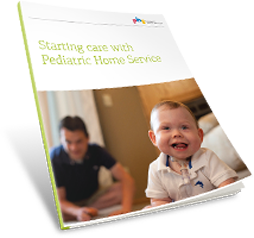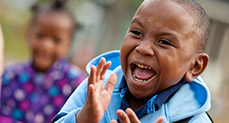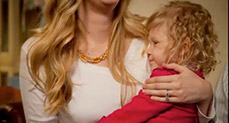Elsa Has One Ventricle, But Plenty of Heart
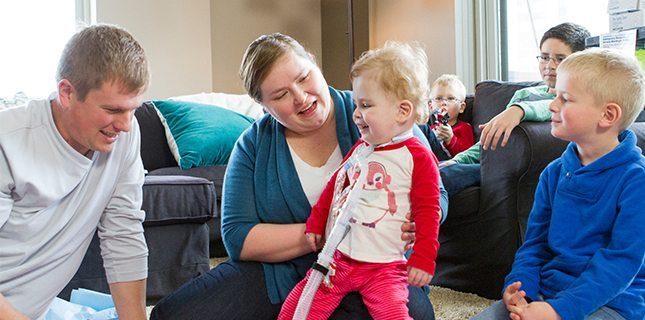
With three brothers at home, Elsa knows how to play – chasing balls, having a particular interest in the loudest toys, and playing peek-a-boo with just about anyone who will participate.
Elsa has spent a large chunk of her two years at the hospital, but now thrives at home thanks to a team of clinicians at PHS and other providers. Barely able to sit up by herself a few months ago, she is now scooting around and moving throughout her home – a testament to the strength she has when she’s able to be near family and familiar surroundings.
“She has a lot of will to live, and you can see it in a home setting,” says Sara, Elsa’s mom.
A Single Ventricle
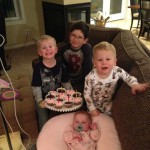 At 18 weeks gestation, Sara and her husband Brent found out Elsa would have a heart defect called tricuspid atresia, meaning she would have one ventricle pumping blood through her body rather than two.
At 18 weeks gestation, Sara and her husband Brent found out Elsa would have a heart defect called tricuspid atresia, meaning she would have one ventricle pumping blood through her body rather than two.
After Elsa was born, they found several other heart defects including total anomalous pulmonary venous and coarctation of the aorta, as well as a genetic abnormality known as cat eye syndrome – a disorder that results from a defect of the 22nd chromosome. These complexities meant Elsa would spend many months in the hospital before eventually discharging to receive care from PHS.
Initial Transition
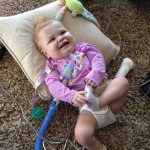 When Elsa first came home in summer 2013, the transition went well – her medical needs weren’t as complex as they are today, but were enough that she needed a nurse monitoring her throughout the majority of each day.
When Elsa first came home in summer 2013, the transition went well – her medical needs weren’t as complex as they are today, but were enough that she needed a nurse monitoring her throughout the majority of each day.
After going back into the hospital that fall for about five months, Elsa’s transition home in January 2014 looked much different. Now trached and requiring a vent, she would need home care nursing, respiratory therapy, and nutrition services from PHS.
“Transitioning from hospital to home was a whole new ball game,” remembers Sara. “We had equipment I thought we’d never need, noises I hadn’t heard before, an entire house of supplies. But knowing PHS would be with us through it was a huge relief.”
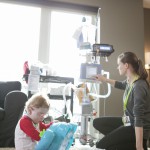 To ensure a successful transition, PHS provided Elsa’s family with in-hospital education as well as in-home hands on training with a respiratory therapist to build complete confidence with supplies, equipment, and circuit building. Soon, she was happily at home and settling into her own schedule while nurses, clinicians and therapists came to her where she was most comfortable and stabilized.
To ensure a successful transition, PHS provided Elsa’s family with in-hospital education as well as in-home hands on training with a respiratory therapist to build complete confidence with supplies, equipment, and circuit building. Soon, she was happily at home and settling into her own schedule while nurses, clinicians and therapists came to her where she was most comfortable and stabilized.
“There’s a lot of education, so I felt as prepared as I could be,” says Sara. “We had hiccups in the very beginning due to heart arrhythmias that had her in and out of the hospital, but we’ve been home now since last March – that’s the longest she’s been out of the hospital her entire life.”
All from one place
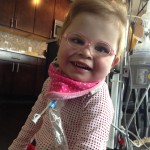 When Sara and Brent first found out they would be using PHS for nursing and equipment, they weren’t sure how it would all come together and assumed supplies would come from different places. There was concern about what to do if something broke.
When Sara and Brent first found out they would be using PHS for nursing and equipment, they weren’t sure how it would all come together and assumed supplies would come from different places. There was concern about what to do if something broke.
Luckily, they quickly learned that PHS would provide not only the nursing and respiratory care, but supplies, repairs, and nutrition. Knowing there was support 24/7 for troubleshooting, critical supply needs or care questions provided them peace of mind.
“We simply cannot be without all of our equipment that we have at home. It’s not an option to run out of a supply or have a piece of malfunctioning equipment with her level of care,” says Sara.
Round-the-clock nursing
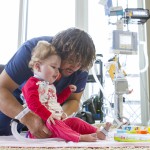 To care for Elsa’s complex needs, PHS home care nurses are there 24/7 to provide critical medication administration, respiratory therapies, and head to toe assessment.
To care for Elsa’s complex needs, PHS home care nurses are there 24/7 to provide critical medication administration, respiratory therapies, and head to toe assessment.
“Having 24-hour nursing for Elsa, trusting someone to come into your home and take care of your most precious gift, was a bit daunting at first,” remembers Sara. “Then you realize they are a very knowledgeable and caring person who takes care of your child wholeheartedly, and turn into someone who basically becomes an extension of your family.”
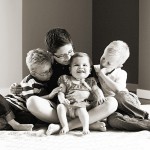 Now, thanks to nursing in the home, Sara and Brent are able to be parents – not only to Elsa, but to their three boys as well. They can also rest easy knowing there is another set of eyes or opinion on Elsa’s status at any given moment.
Now, thanks to nursing in the home, Sara and Brent are able to be parents – not only to Elsa, but to their three boys as well. They can also rest easy knowing there is another set of eyes or opinion on Elsa’s status at any given moment.
“Having nursing in our home gives me a chance to be a mom versus always being the person who is always administering medication. Elsa can see me and Brent as parents versus a caregiver. We’re always her caregivers, but it’s nice to just be a mom sometimes too.”
Being together at home
Comprehensive care at home means Elsa spends more time out of the hospital – a welcomed option for Sara and Brent, who would otherwise have to divide their time between being in the hospital with their daughter or at home with their boys.
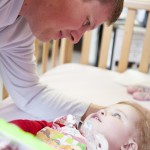 “Being at home, Sara gets to read our sons stories before they go to bed, give them baths,” says Brent. “And I get to tuck Elsa in at night, play with her, and help with her cares, instead of us having to go our separate ways because Sara is staying at the hospital with Elsa and I’m taking care of the boys.”
“Being at home, Sara gets to read our sons stories before they go to bed, give them baths,” says Brent. “And I get to tuck Elsa in at night, play with her, and help with her cares, instead of us having to go our separate ways because Sara is staying at the hospital with Elsa and I’m taking care of the boys.”
“PHS has been able to give us a gift that we can never ever pay back, and that’s the ability to be a family,” Sara adds.
Sara and Brent also know that being at home rather than the hospital means a decreased exposure to germs for Elsa, helping to keeping her on track with making progress rather than having to fight a virus that she picked up.
Focusing on repair
 While Elsa gains strength at home, the focus is on two heart surgeries she has in her future. The first repair was delayed when Elsa got her trach and ventilator, so she is currently working to stabilize without the assistance of her ventilator. Once she’s at that point, the surgery can be performed. Her heart defect is not one that is fixed and forgotten, but surgeries serve as a bridge to allow her single ventricle to function more efficiently.
While Elsa gains strength at home, the focus is on two heart surgeries she has in her future. The first repair was delayed when Elsa got her trach and ventilator, so she is currently working to stabilize without the assistance of her ventilator. Once she’s at that point, the surgery can be performed. Her heart defect is not one that is fixed and forgotten, but surgeries serve as a bridge to allow her single ventricle to function more efficiently.
“Once those surgeries reach their limit, then kids typically end up needing a heart transplant at some point,” says Sara. “But that’s years away, hopefully, and we just look forward to getting the next repair to her heart.”
For now, they mostly do normal things two year olds do – playing, snuggling, and napping – at home. You can learn more about a day in the life of Elsa, her home care nurses and her family in this video.
Originally published: January 21, 2015